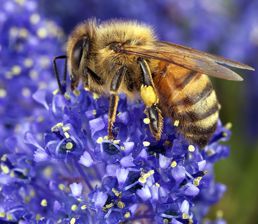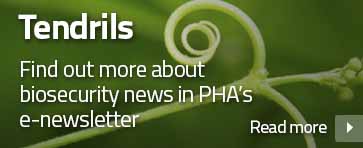 The Australian Honey Bee Industry Council (AHBIC) is the peak honey bee industry body that represents the interests of its member state beekeeping organisations and beekeepers from around Australia. Responsibilities of the representative body include:
The Australian Honey Bee Industry Council (AHBIC) is the peak honey bee industry body that represents the interests of its member state beekeeping organisations and beekeepers from around Australia. Responsibilities of the representative body include:
- biosecurity planning and implementation at the national and farm levels
- liaising with federal and state governments on trade issues
- funding and supporting biosecurity initiatives
- participating in national committees and response efforts in an emergency.
Industry overview
The industry also exports live bees, and Australian beeswax commands a premium price overseas. Trade relies on the healthy status of Australia’s bees, with high values attributed to the lack of residue from miticides that are used overseas to treat Varroa mites.
The National Bee Biosecurity Program
Expand
 |
The honey bee industry also funds the National Bee Biosecurity Program, a partnership between industry and government, which employees Bee Biosecurity Officers (BBO) in all Australian states. BBOs provide training and education to help beekeepers implement biosecurity measures and ensure they are complying with the Code of Practice and relevant legislation. |
The National Bee Pest Surveillance Program
Expand
The National Bee Pest Surveillance Program is an early warning system to detect new incursions of exotic bee pests and pest bees. The program involves a range of surveillance methods conducted at sea and air ports throughout Australia considered to be the most likely entry points for bee pests and pest bees.
Exotic bee pest and pest bee early warning
To act as an early warning system to detect new incursions of exotic bee pests and pest bees. This greatly increases the possibility of eradicating an incursion and limits the scale and cost of an eradication program.
The program is jointly funded by the Australian Honey Bee Industry Council, Hort Innovation, Grain Producers Australia and the Australian Government Department of Agriculture and Water Resources. In-kind contributions for the implementation of the program are provided through each state and territory Department of Agriculture as well as volunteer beekeepers. At a national level, PHA coordinates and administers the program.
 |
Fact sheetAbout the National Bee Pest Surveillance Program This summary document includes the objectives of the program, methods used for surveillance, the role of PHA in the program and the sources of funding. |
Biosecurity plans, manuals and resources
Expand
 |
Biosecurity planning provides a mechanism for the honey bee industry, government and other relevant stakeholders to assess current biosecurity practices and future biosecurity needs. Planning identifies procedures that can be put in place to reduce the chance of pests reaching our borders or minimise the impact if a pest incursion occurs.
The Industry Biosecurity Plan for Honey Bee Industry outlines key threats to the industry, risk mitigation plans, identification and categorisation of exotic pests and contingency plans. For a copy, please contact PHA on 02 6215 7700 or email biosecurity@phau.com.au |
 |
The Biosecurity Manual for Beekeepers provides information for the industry and producers about biosecurity practices and honey bee pests. |
 |
The Australian Honey Bee Industry Biosecurity Code of Practice (the Code) provides a framework for beekeepers to use best-practice biosecurity measures.
The Code has been developed to incorporate fundamental biosecurity principles into the practices of all Australian beekeepers including:
Biosecurity Online TrainingHoney bee biosecurity module – a short awareness course based on the Biosecurity Manual for Beekeepers. It provides an introduction to biosecurity best practice, hive inspections, surveillance, moving hives and how to report a suspect Emergency Plant Pest. Biosecurity for Beekeepers – provides advice on keeping honey bees healthy using industry best practice. This course supports the Australian Honey Bee Industry Code of Practice and is one way to meet the training requirement of the Code. |
 |
Workshop AcariThe potential impacts of a Varroa mite detection, and the ensuing response, on the pollination-dependent industries was investigated at Workshop Acari. Government regulators, pollination providers, and representatives from the beekeeping and pollination-dependent industries interacted with international and Australian experts through a mixture of key note presentations and discussion activities. The workshop demonstrated to apiarists, the almond and other pollination-dependant industries how to prepare for, and act in, an incursion. More information on the workshop can be found in the Workshop Report. Workshop Acari built on the report Varroa Mite Preparedness of Pollination Dependent Industries. |
Other biosecurity projectsInformation about the following projects is available in the National Programs section of this site.
|
|
Apiary biosecurity formsThe following forms are available as editable pdf documents: |
|
 |
Apiary biosecurity signsThere are two templates for biosecurity signs:
|
 |
PostcardPromotional postcard to support the exotic plant pest hotline 1800 084 881 |
 |
BrochureThe Honey bee biosecurity threats brochure describes established and exotic pests of honey bees in Australia. |
Pests Expand
Exotic pests (not in Australia)
The following is a list of high priority exotic pests of honey bees. These pests were identified during the development of the Industry Biosecurity Plan for the Honey Bee Industry in consultation with industry, government and scientists. They have been assessed as high priority pests based on their potential to enter, establish, and spread in Australia (eg environmental factors, host range, vectors) and the cost to industry of control measures.
PHA has a range of fact sheets, contingency plans and diagnostic protocols relevant to these pests. Please contact PHA on 02 6215 7700 or email biosecurity@phau.com.au for more information.
| Common name | Scientific name | EPPRD Category | Fact sheet | Contingency plan | Diagnostic protocol |
|---|---|---|---|---|---|
| Acute bee paralysis virus (ABPV) | Acute bee paralysis virus (Cripavirus) | ||||
| African honey bee | Apis mellifera scutellata | ||||
| Africanised honey bee | Apis mellifera scutellata (hybrid) | FS | |||
| Asian honey bee | Apis cerana (exotic strains, genotypes and sub-species) | FS FS | |||
| Cape honey bee | Apis mellifera capensis | FS | |||
| Deformed wing virus | Deformed wing virus (Iflavirus) | ||||
| Hornets | Vespa spp. (exotic species) | FS | |||
| Large hive beetle | Hoplostoma fuligineus | FS | |||
| Slow paralysis virus | Slow paralysis virus (Iflavirus) | ||||
| Tracheal mite | Acarapis woodi | FS FS | |||
| Tropilaelaps mites | Tropilaelaps clareae and Tropilaelaps mercedessae | FS FS | |||
| Varroa mites | Varroa destructor and Varroa jacobsoni | FS FS |
Other pests
The following is a list of documents for established pests of the honey bee industry. Please note that this is not a complete list of pests: rather it includes pests for which documents exist in the Pest Information Document Database.
| Common name | Scientific name | EPPRD Category | Fact sheet | Contingency plan | Diagnostic protocol |
|---|---|---|---|---|---|
| American foulbrood | Paenibacillus larvae | FS | |||
| Black queen cell virus | Black queen cell virus (Cripavirus) | FS | |||
| Braula fly | Braula coeca | FS | |||
| Chalkbrood disease | Ascosphaera apis | FS | |||
| European foulbrood | Melissococcus plutonius | FS | |||
| Greater wax moth | Galleria mellonella | FS | |||
| Lesser wax moth | Achroia grisella | FS | |||
| Nosemosis | Nosema apis and N. ceranae | FS | |||
| Sacbrood virus | Sacbrood virus (Iflavirus) | FS | |||
| Small hive beetle | Aethina tumida | FS |





Recent Comments